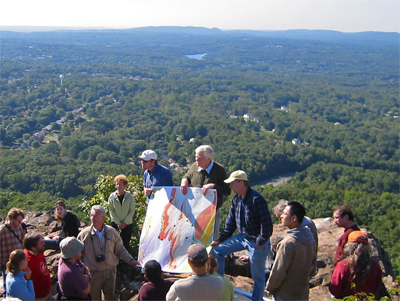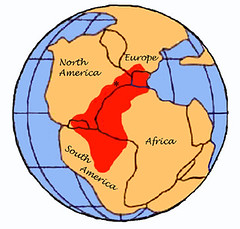Geo: Time and place
We never know when something extraordinary is about to happen, when streams of time might run together for an instant before parting. Listening to Jelle DeBoer lecture about the Age of Volcanism in the Connecticut Valley last Sunday, from atop the Hanging Hills of Meriden with the Sleeping Giant behind him was one such moment.

DeBoer (center) and Phil Resor (middle right with tan cap), professors of geology at Wesleyan University, led a field trip for a group of geologists from around the northeast, one offered as part of the New England Intercollegiate Geological Conference here last weekend. With them were geologists Tony Philpotts of UConn (middle left in tan jacket) and Greg McHone (not pictured).
Beloved as the Stearns Professor of Earth Science at Wesleyan, Jelle is an expert on the lavas that flowed over and through the Connecticut Valley some 200 million years ago to form our traprock ridges, such as the Hanging Hills, Sleeping Giant and Talcott Mountain, and rocky craigs such as West Rock and East Rock.
In recent years, a new theory about the origin of these rocks has emerged. Drs. Philpotts and McHone are testing the idea that local traprock ridges were a small part of volcanic events that flooded the center of the former supercontinent of Pangea with molten rock. They describe the area—which today stretches around the Atlantic, across parts of Canada, the eastern US, Europe, South America and Africa—as the CAMP, or Central Atlantic Magmatic Province.

An illustration showing the area of the CAMP by Greg McHone, after a map by Paul E. Olsen. The red area indicates the portion of Pangea (including New England) Greg McHone believes was overspread by flood lavas in the Early Jurassic.
Standing together there atop the Hanging Hills on that perfect October day, streams of time converged. There was Jelle DeBoer, standing confidently atop the ancient volcanic rocks, lecturing about events in the deep past he has spent a lifetime researching, and serving as a focal point for a stirring conversation about new discoveries still being made here today. Then, of course, it came time for all of us to go on to the next stop.
1 Comments:
What a nice site you have here! I read about it in today's Times and will bookmark it. We like to explore our state, too.
Post a Comment
<< Home